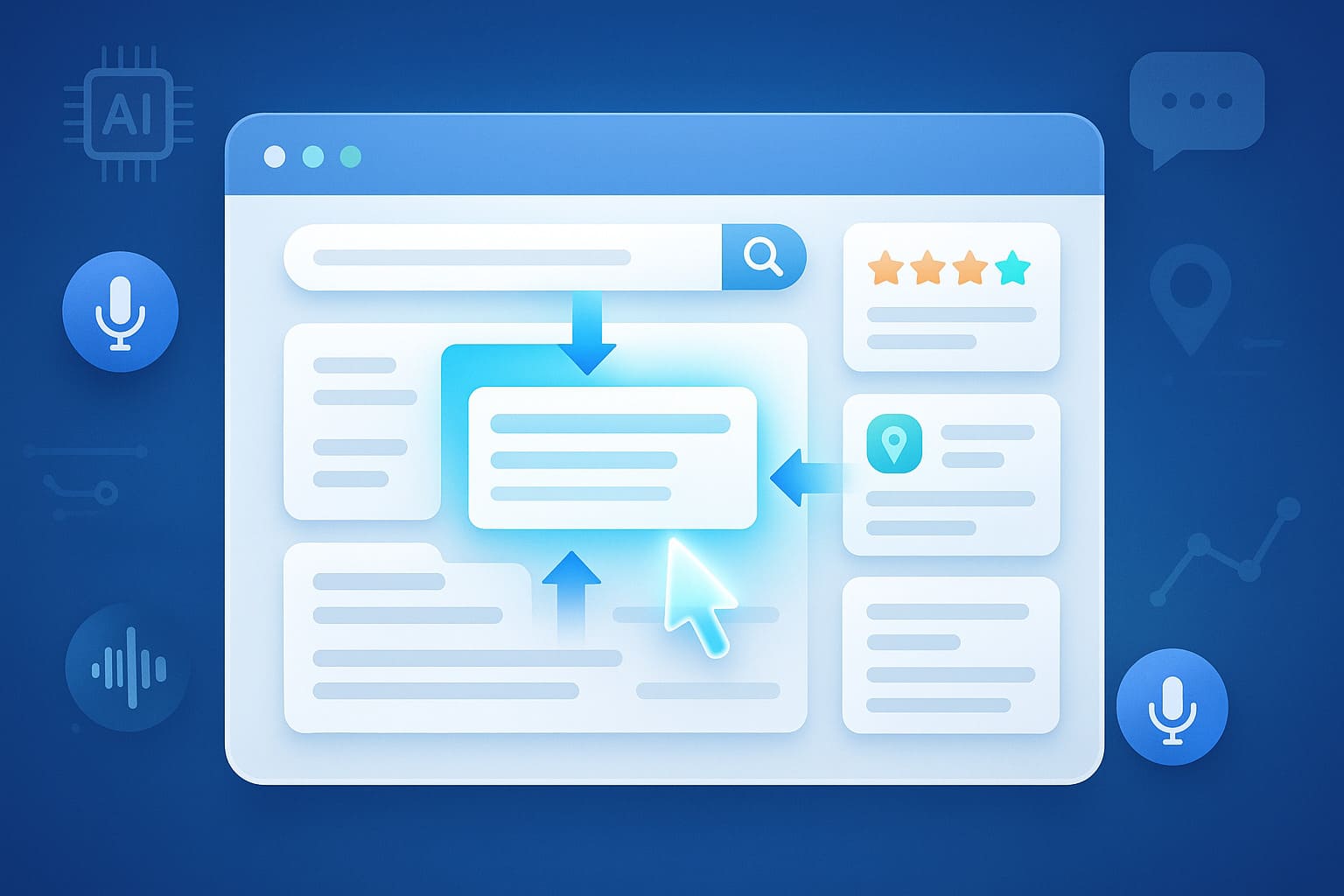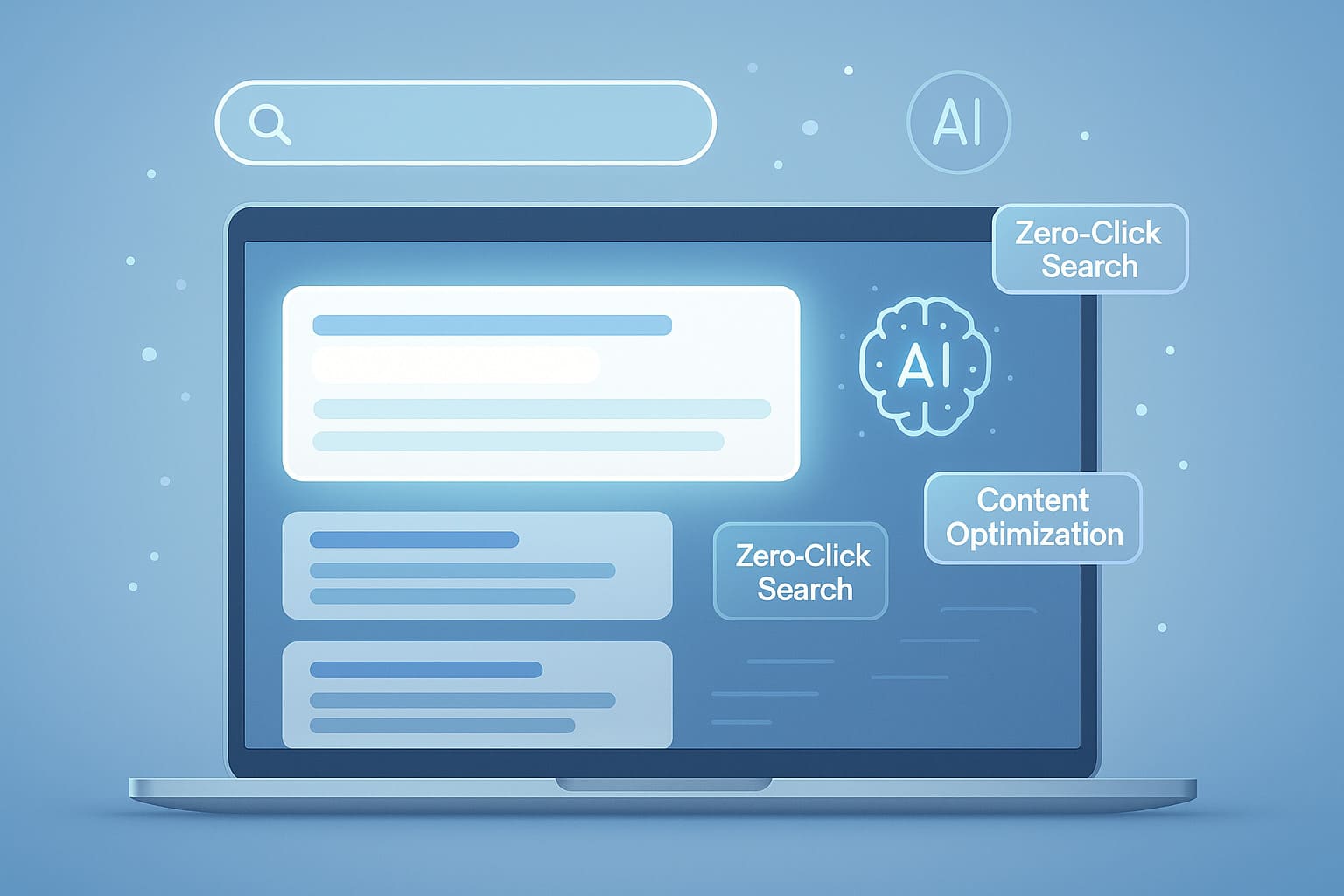Zero-click searches are growing faster than many website owners expected. A recent study by Semrush found that about 25.6% of desktop searches and 17.3% of mobile searches end without any click at all. Users are getting their answers right there on the Search Engine Results Page (SERP), without visiting any website.
Today, Featured Snippets, Direct Answer Boxes, and AI Overviews (SGE) are the new normal. Google pulls the most useful content to the top. It shows facts, steps, and images without asking users to leave the search page.
The good news is, if your content matches the right User Intent and uses proper Schema Markup like FAQ Schema or Speakable Schema, you can still win big. Websites that adapt are seeing higher visibility in zero-click SERPs even if the clicks are fewer.
Ranking in 2025 is not just about getting clicks anymore. It is about getting seen, trusted, and remembered. Sites that master context-aware responses, answer-first content, and smart use of entity-based SEO will lead the race.
What Is a Zero-Click Search and Why It Matters in 2025
A zero-click search happens when a user finds the full answer right on the Search Engine Results Page (SERP) without clicking any website link. Google displays instant answers, knowledge panels, or featured snippets that solve the query in seconds.
By 2025, zero-click searches are expected to cover even more types of queries. With AI Overviews (SGE) growing, searchers are getting used to multi-step answers layered inside the results page itself. Google’s focus has shifted to serving users faster with less friction, using features like Direct Answer Boxes, People Also Ask (PAA), and Local Pack maps.
This shift matters because traditional SEO was about getting the click. Now, it is about earning SERP dominance — being the source that Google picks to feature. Brands that master answer-first content and entity-based SEO techniques will stay visible even when clicks vanish.
Recent studies, like the Semrush Zero-Click Research, show that brands winning featured snippet optimization enjoy 24% more brand recall, even without users clicking. In simple words, showing up where people look builds trust faster than ever before.
Winning 2025 SEO is not only about being clickable. It is about being unforgettable.
Types of Zero-Click Search Results You Must Know
Zero-click searches are growing faster than people realize. Across the Search Engine Results Page (SERP), answers are now given before users even think of clicking. It changes how websites must plan their visibility.
Here are the most important types you must understand:
Featured Snippets
Featured Snippets are short answers shown at the very top of Google. You often see them when searching simple “what,” “how,” or “why” questions.
For instance, if you search “how to bake bread,” Google pulls a small guide from a page and shows it immediately.
No click needed.
Ahrefs found that about 8.6% of all clicks now go to pages ranking in featured snippets (source).
If you want your page to win, use tight answers, clean formatting, and keep it between 40 to 50 words.
Direct Answer Boxes
A Direct Answer Box gives basic facts like time, dates, age, calculations, and weather. Google itself answers the query without linking anywhere.
Direct Answer Boxes do not pull from websites. They give basic facts straight from Google’s own knowledge base. If you search “current time in Tokyo,” the answer shows right there, no links.
This space is usually filled by government sites, Wikipedia, or trusted databases. It is tough for new brands to win, but studying how they present information helps build stronger trust signals.
People Also Ask (PAA)
This one feels like Google whispering, “Hey, are you wondering about this too?”
PAA boxes show up like expandable mini-FAQs under the main search results. You click one — and it unfolds a mini-answer from a website, plus spawns more questions automatically. It is endless.
Real talk: Backlinko’s latest study found that over 43% of Google SERPs now have PAA boxes (source).
Winning PAA is all about clear FAQ sections, fast answers, and smart structure. You are not just answering — you are becoming part of the bigger search journey.
Knowledge Panels
When you google a brand like “Tesla,” you do not just get links — you get a Knowledge Panel.
A full info-box floats on the right, packed with facts, links, images, and sometimes social profiles.
This is what happens when you nail Entity-Based SEO. Google understands you as a “thing,” not just a URL.
Pro Tip: Make sure you set up strong structured data, claim your Google Business Profile (GBP), and keep facts consistent across the web.
When you show up in a Knowledge Panel, you do not just look legit — you own attention.
Local Pack
Imagine searching for “pizza near me” — what pops up?
The Local Pack: three business listings, map pins, star ratings, and direct calls-to-action.
Getting into the Local Pack is gold for local businesses. A BrightLocal 2024 survey found that 44% of local clicks happen inside the Local Pack (source).
If you want a shot, you need:
- A strong Google Business Profile
- Real reviews
- Tight NAP consistency (Name, Address, Phone)
No shortcuts here. Local SEO is real-world SEO now.
AI Overviews (SGE)
AI Overviews is part of Google’s Search Generative Experience (SGE). Instead of showing ten links, Google gives users a stitched-together summary from different trusted websites.
And guess what? When users get everything at once, clicks fall — but visibility explodes.
If you want your content blended into an AI Overview, focus on:
- Fact-driven writing
- High Content Readability Improvements
- Deep Context-Aware Responses
The goal is to sound so clear and trusted that Google’s AI cannot resist picking you.
Quick Snapshot
| Type | What Happens | Why It Matters |
| Featured Snippet | Instant answer from your page | Double visibility boost |
| Direct Answer Box | Google answers without links | Trust = survival |
| People Also Ask | Expandable questions/answers | Surface area dominance |
| Knowledge Panel | Sidebar facts for brands | Entity SEO proof |
| Local Pack | Map + top 3 local listings | Local clicks winner |
| AI Overview (SGE) | Summarized answer by AI | Visibility without clicks |
You do not need to fight the zero-click world. You need to become the answer. Pages built for information satisfaction, fast answers, and entity trust will rule 2025.
Best Practices to Optimize for Zero-Click Searches
Zero-click searches do not have to feel like lost opportunities. In fact, smart brands are turning them into visibility wins without needing users to click.
The key is adapting how you write, structure, and signal your content to match what Google now rewards.
Here are the real best practices you must follow to win the zero-click searches in 2025:
1. Optimize for Featured Snippets and People Also Ask (PAA)
Appearing on Google’s SERP today often means getting picked for Featured Snippets or People Also Ask (PAA) spots.
You do not need a lucky break — you need smart structure.
A study showed that rewriting pages for snippet rules lifted page views by 22% in 90 days.
Here is how to grab them:
- Frame H2s as questions users search for.
- Answer clearly below in 40–50 words.
- Use lists, tables, or steps to match user expectations.
For Featured Snippets, short punchy summaries work best. For PAA boxes, make answers direct, factual, and linked naturally to follow-up questions.
Backlinko’s 2024 PAA Research found pages winning one PAA box often snowball into multiple related questions (source).
Best move? Add a tight FAQ section, clean headings, simple sentences, and keep Content Readability Improvements at the center.
Google’s NLP picks up clarity, not clutter.
Winning snippets and PAA is not magic. It is clean writing, smart structure, and answering users better than anyone else.
2. Create Direct, Crisp Answers
Zero-click search is ruthless. To survive, your answers must hit straight at the heart of the question.
Instead of warming up, get to the point in the very first line. Search Engine Land’s 2024 guidelines recommend using a clear “is” statement and defining the topic within two to three short sentences. They also suggest shaping answers to match the featured snippet optimization format. (Source: Search Engine Land)
Here is how you sharpen your direct answers:
- Begin with a complete thought — a full solution right at the start.
- Avoid winding explanations. Solve the user’s needs immediately.
- Keep it within 40–60 words — no less, no more.
Example: When someone types “What is Schema Markup?” into Google, your answer should land like this:
Schema Markup is code that helps search engines understand a webpage’s content better. It improves visibility through rich results such as ratings, images, and FAQs.
Simple. Strong. Done.
By tightening your first two sentences, you invite Google NLP system to pull your page into Featured Snippets easily. No fancy tricks needed — just pure information, clean and crisp.
3. Implement Schema Markup Properly
If search engines cannot understand your content clearly, they will skip over you. That is where Schema Markup steps in.
Schema is like giving Google a map. It tells machines exactly what your page holds — whether it is a guide, a FAQ, a review, or a product listing.
Real-world SEO experiments prove this matters.
A study by Search Engine Journal found that pages using valid structured data got up to 35% more clicks compared to those without it. (Source: Search Engine Journal)
Here is how to add Schema the smart way:
- Add FAQ Schema for your question-answer sections.
- Apply HowTo Schema if your page gives step-by-step guides.
- Use Product Schema if you are selling something.
- Mark author profiles with Person Schema to build real trust.
After adding it, always test your code using the Rich Results Test Tool. Fix every error — even small ones — before publishing.
Webmasters in Google’s community forums often share that after fixing their Schema errors, they saw faster inclusion into People Also Ask (PAA) boxes — sometimes within two to three weeks.
In 2025 SEO, Schema is not a “nice-to-have.” It is the starting point if you want to get picked for rich results.
4. Improve Content Readability and Scannability
In zero-click searches, users barely spend 5 seconds scanning a page.
If your content looks messy, too long, or hard to skim, Google will skip it for snippets or People Also Ask (PAA) boxes.
Real data from NNGroup’s Eye-Tracking Research 2024 shows that users scan content in an F-pattern — first looking at headings, then short bursts of text. (Source)
To match this behavior, you must:
- Break content into small paragraphs — 2 or 3 sentences maximum.
- Use clear subheadings (H2s, H3s) that directly match user questions.
- Add bullet points or numbered lists wherever possible.
- Highlight important phrases naturally (bold key ideas, not random words).
Example: Instead of writing a heavy block explaining Schema Markup, create a short paragraph, a quick list of types, and a final tip in a new line.
Experts at Content Marketing Institute confirmed that making pages easier to scan improved snippet capture rates by over 27% compared to bulky paragraphs. (Source)
In 2025, Content Readability Improvements are not a bonus. They are a baseline if you want Google to even consider your page for zero-click search.
5. Structure for AI Summaries and Speak-able Schema
In 2025, Google’s AI Overviews pick content based on how clearly and quickly it answers. If your structure is messy, even great information gets ignored.
A study by Path Interactive (now Amsive Digital) showed that Google prefers well-structured pages with defined sections when pulling AI summaries. (Source)
Here is how to structure content ready for AI and voice:
- Place direct, short answers within the first 2–3 sentences of a section.
- Use FAQ Schema and HowTo Schema to signal organized content.
- Write headings as full questions users might ask (e.g., “How does Schema Markup improve SEO?”)
- Keep sentences sharp — no over-explaining or adding fancy phrases.
- Use active voice to match Speakable Schema standards (ideal for Google Assistant and voice search).
For example: If you explain “How to change a car battery,” start with a one-line answer, follow with a simple list, and use clear step-by-step labels.
Research from Backlinko Voice Search Study 2024 also found that short, conversational answers (29-word average) are 2x more likely to be picked for voice-based summaries. (Source: Backlinko Voice SEO Study)
When you Structure for AI Summaries, you speak not just to users — you speak directly to Google’s ranking brain.
6. Implement Local SEO for Local Pack Placement
If your business shows up inside the Local Pack, you win visibility even without clicks.
Google shows a map, top 3 business listings, ratings, hours — everything a user needs at a glance.
A real-world study by BrightLocal’s Local Consumer Review Survey 2024 found that businesses appearing in the Local Pack earned 44% of all local clicks, even when users did not click through. (Source: BrightLocal 2024 Local SEO Survey)
To secure your place:
- Fully optimize your Google Business Profile (GBP) — make sure name, address, phone, website, and hours are correct.
- Use strong categories that match searcher intent (example: “Emergency Dentist” not just “Dentist”).
- Add high-quality photos and keep updating posts and offers.
- Collect real reviews regularly and reply to each review politely.
- Keep NAP Consistency across all online directories (Name, Address, Phone must match exactly).
Webmasters on Local Search Forum shared that after fixing inconsistent directory listings and posting weekly updates on GBP, they improved their Local Pack visibility by 38% in under 3 months. (Source: Local Search Forum Case Discussions)
In Local SEO, visibility is not about who spends the most. It is about who stays clean, real, and consistently active.
How to Pick Keywords That Actually Work in 2025
In 2025, picking keywords is not just about finding search volume. It is about choosing the ones that open up real space on the Search Engine Results Page (SERP).
Smart Keyword Research starts by checking which SERP features show up — like Featured Snippets, People Also Ask (PAA), or Local Pack results.
To pick better:
- Open the Keyword Magic Tool and filter by SERP Features. Focus on terms linked to snippets, PAA, or rich results.
- Avoid keywords that trigger only Direct Answer Boxes. These answers are complete inside Google, and users rarely click through.
- Target search terms that show clickable features — where users explore more, not just read and leave.
- Always match the Search Intent. Choose keywords where people want to learn, buy, or dig deeper, not just check a fact.
Choosing the right keyword today means chasing where the clicks still happen — not where they disappear.
Track and Improve Your Zero-Click Performance
Winning a spot is just the start. Staying visible inside zero-click searches needs monthly tracking and smart updates.
First, set up the Position Tracking Tool for your important keywords. You must know who owns the Featured Snippets, People Also Ask, and Local Pack spots — not just your ranking.
Next, watch how your Rich Results show up. If your listings appear inside maps, snippets, or FAQs, mark those pages separately.
Now, a very important shift for 2025: Forget only chasing click-through rate (CTR). Google’s new focus is on Visibility Metrics — how often your page appears inside search features, even without a click.
Here is a simple breakdown:
- Track Featured Snippets, PAA, and Local Pack separately
- Measure impressions, not just clicks
- Tag pages that win zero-click spots for extra updates
- Refresh winning content every 60–90 days
- Watch for sudden losses and investigate immediately
If you find a page getting lots of impressions but no actions, improve the title, meta description, or call-to-action naturally.
Good tracking is not about numbers. It is about learning real user behavior and improving context-aware responses across the search journey.
Final Checklist: Zero-Click SEO Action Plan 2025
You can read hundreds of tips, but winning in zero-click SEO needs simple, sharp action.
Here is your Zero-Click Searches checklist:
- Create Direct Answers naturally inside your content
- Optimize FAQ sections using proper FAQ Schema
- Build strong HowTo Schema for step-by-step guides
- Strengthen Local SEO and dominate the Local Pack
- Improve your Entity-Based Content Authority
- Track SERP Feature Wins every month with Position Tracking Tool
- Focus on Visibility Metrics, not just click-through rates
- Update your winning pages every 60–90 days for freshness
- Monitor User Behavior Analysis to keep refining your pages
Important Tip:
Do not chase traffic alone. Winning zero-click is about context-aware responses, building a multi-channel entity presence, and matching real user intent every time.






